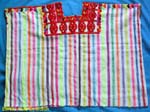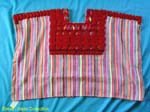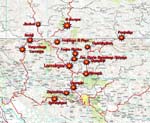 |
 |
 |
| San Pedro Chenalho is the capital of the large Municipio of Chenalho. The paved road to Pantelho passes above the valley in which the town is located. We drove into Chenalho in April 2003 searching for any textile coops that might be in town. The day was cold and rainy, and not many people were out. We passed groups of young men, who looked at us with suspicion. (We think a great deal of the suspicion that we encountered in many Maya villages came from the mistaken belief that we were foreign Evangelical missionaries. There exists a high level of religious tension in many areas between Maya who have converted to Protestant religions, and Maya who remain Catholics. Some municipios like Chamula have driven out the Protestants, who have formed their own communities elsewhere (“colonias”). To complicate matters, several thousand Maya have converted to Islam). We drove around town in the rain and never saw anything that looked like a weaving coop. As we were heading back to the main road, we passed a small tienda that had a huipil draped over a rope outside the shop. This generally means the article is for sale. We asked the woman running the shop if she was selling the huipil, and she said "yes." This one-web huipil is made of striped multi-colored cotton. It has an area of dense red embroidery on both sides and along the shoulders. The diamond-patterned designs are said to represent the universe. Comparing this huipil to a Chenalho huipil from about 10 years earlier, one can see how much denser the decoration has become. People have acquired more money with which to buy the raw materials used to make and decorate their clothing. These huipiles are worn with the typical indigo-dyed skirts and red belts like those worn in Mitontic. We didn’t see any men in traditional clothing in Chenalho. We’ve read that only a small percentage of young Chenalho women learn how to weave, but they definitely know how to embroider. As we drove through the municipio, we saw many young women standing in their doorways or sitting in their yards embroidering huipiles. The hamlet of Acteal, which was the site of the horrific 1997 massacre of women and children, is part of Chenalho Municipio, and this area has been the location of a great deal of political and religious violence. Many thousands of people have been displaced from their homes because of the turmoil. Some people have settled in the autonomous Zapatista Municipio of Polho, which lies about 25 kms down the road. |
|
Home - The Collection - Favorite Photos- Bob's Top 10 - Textile Patterns - The Villages - Participate
For more information or comments please contact me at: info@mexicantextiles.com © 2005 Bob Freund All Rights Reserved |